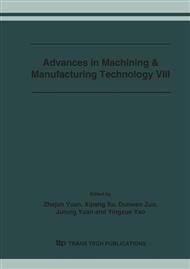p.656
p.661
p.666
p.671
p.676
p.681
p.686
p.691
p.696
Influence of Tooling Parameters in High-Speed Milling of Hardened Steels
Abstract:
Tool life, surface roughness, and cutting forces have always remained extremely important output parameters of milling process. In this paper an attempt has been presented in order to study the influence of cutter geometry and cutter coating upon these three output parameters. Series of high-speed side milling experiments were done upon hardened AISI 4340 and AISI D2 steels using coated and uncoated carbide cutters. Mechanisms of wear occurring in different tools have been described in the paper using SEM photographs and micro-analysis of the tool surface. The analysis of experimental data shows that the coated carbide cutters having high values of helix angle and small values of rake angle, in the negative range, provide the better optimization of highspeed milling of hardened steels. Results imply that tool geometry and coating are influential upon cutting forces and tool wear but not upon surface quality. Introduction of MQL in the process leads the tool to fail abruptly because of the onset of chipping.
Info:
Periodical:
Pages:
676-680
Citation:
Online since:
July 2006
Authors:
Keywords:
Price:
Сopyright:
© 2006 Trans Tech Publications Ltd. All Rights Reserved
Share:
Citation:


